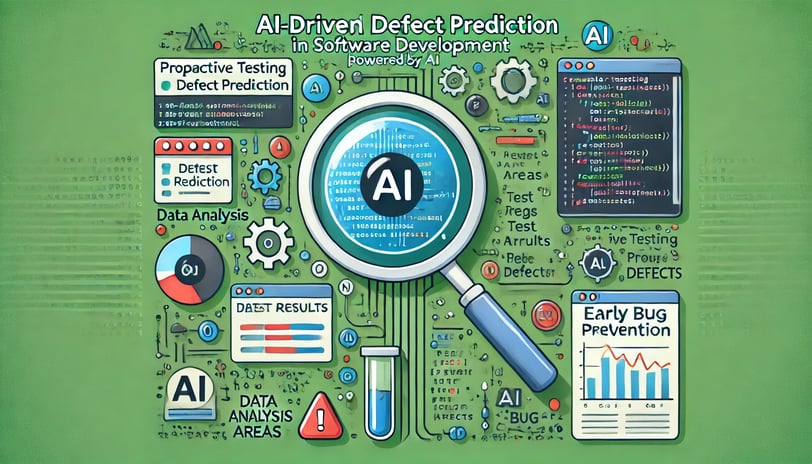AI-Driven Defect Prediction
Identifying Issues Before They Impact Your Software
3 min read


One of the biggest challenges in software development is identifying defects in code early enough to prevent delays and costly production issues. Defects that go unnoticed until the later stages of development or even after release can result in significant setbacks, including lost revenue, diminished user experience, and increased maintenance costs.
This is where AI-driven defect prediction can revolutionize your testing process. By using artificial intelligence, you can predict which areas of the application are most prone to defects, allowing your team to focus testing efforts on these high-risk areas and catch problems before they escalate.
The Problem: Late Detection of Defects
In a traditional software development cycle, defects are often discovered late in the process, particularly when:
Code Complexity Grows: As more features are added, the codebase becomes harder to manage and more susceptible to bugs.
Manual Testing is Overwhelmed: With a growing number of test cases and a limited amount of time, it’s easy for manual testers or automated test suites to overlook certain areas of the application.
Lack of Historical Data Utilization: Traditional testing processes don’t always take full advantage of historical data from past tests and bug reports, which means patterns that could indicate future issues are often missed.
These factors combine to create a testing environment where bugs can slip through the cracks, leading to costly delays and last-minute scrambles to fix problems.
The AI Solution: Predicting Defects Before They Occur
Artificial intelligence offers a solution to these challenges by predicting which parts of the code are most likely to contain defects before they even arise. Here’s how AI-driven defect prediction works:
Analyzing Historical Data:
AI models can be trained using historical test results, logs, and data from previous bug reports. These models learn to identify patterns in areas of the code that are frequently associated with defects.
The AI uses this knowledge to predict which areas of the code are likely to develop similar issues in the future.
Prioritizing High-Risk Areas:
Once the AI model identifies areas of the code that are prone to defects, testing efforts can be focused on these high-risk sections. This allows the team to catch potential bugs early in the development cycle, preventing them from escalating into major issues later.
By concentrating testing resources on critical areas, AI helps optimize the testing process, saving both time and effort.
Learning from Changes:
AI continuously monitors changes in the code, including new features and modifications. By analyzing these changes in real-time, the AI can make informed predictions about the likelihood of defects emerging in specific areas of the application.
This means that as the software evolves, the AI adapts to ensure that testing is always focused on the most relevant areas.
Reducing False Positives:
Traditional defect detection methods often generate false positives, which can overwhelm development teams and slow down the testing process. AI-driven defect prediction reduces the number of false positives by learning from past experiences and refining its prediction algorithms over time.
Benefits of AI-Driven Defect Prediction
Early Bug Detection: AI helps identify defects early in the development process, reducing the risk of costly last-minute fixes and ensuring smoother releases.
Improved Testing Efficiency: By focusing testing efforts on high-risk areas, teams can streamline the testing process and reduce the time spent on less critical sections of the application.
Smarter Resource Allocation: AI allows teams to allocate testing resources more efficiently, ensuring that critical areas receive the attention they need without overloading the team.
Continuous Improvement: As the AI learns from each iteration of testing, it becomes better at predicting defects and minimizing potential risks.
How AI-Driven Defect Prediction Transforms Software Development
Integrating AI into the defect prediction process doesn’t just improve testing — it transforms the entire software development lifecycle. By using AI to predict and prioritize potential issues, development teams can:
Minimize Production Issues: Catching defects early means fewer bugs in production, which translates into fewer disruptions for users and less pressure on your support teams.
Accelerate Time to Market: When testing is optimized through AI-driven predictions, development cycles become faster and more efficient, allowing teams to release high-quality software more quickly.
Ensure Higher Quality Software: With AI working alongside your testing teams, you can ensure that each release meets the highest quality standards by targeting the areas most likely to cause problems.
Implementing AI-Driven Defect Prediction at Digikemet
At Digikemet, we help organizations integrate AI-driven defect prediction into their testing workflows. By analyzing past test results and code changes, we train AI models to predict future defects and optimize testing efforts. This allows our clients to:
Proactively address potential bugs.
Reduce test execution time.
Improve the overall quality of their software, all while keeping costs under control.
Conclusion
Our AI-driven approach allows businesses to stay ahead of potential issues and ensure their software is always ready for release.
